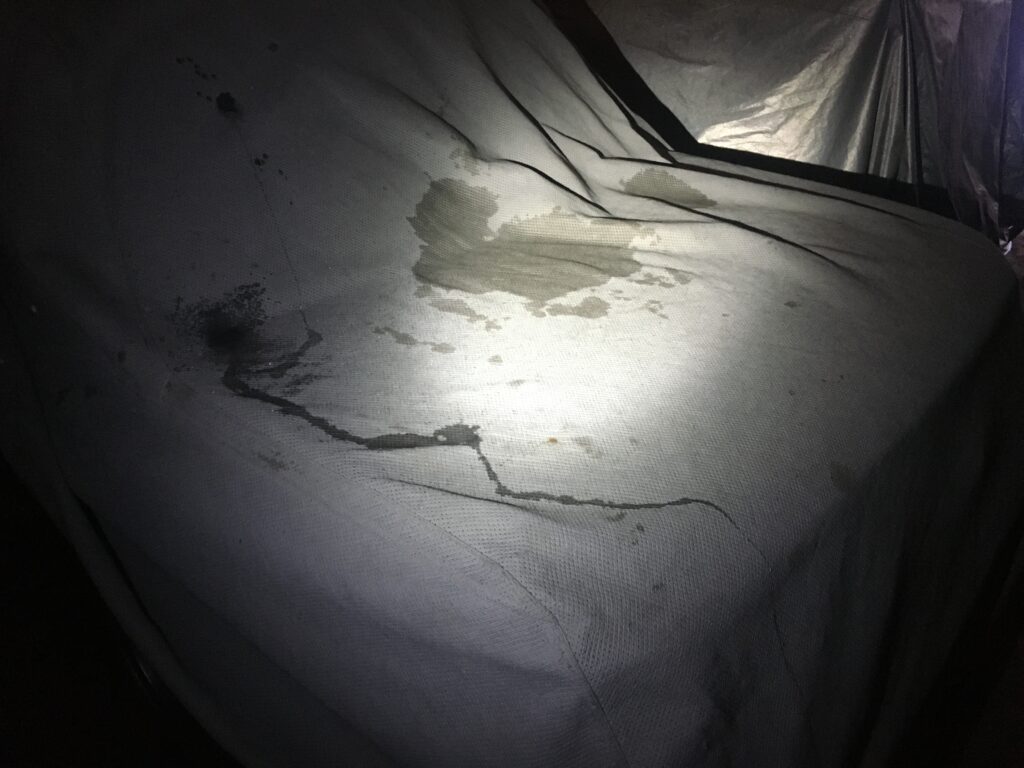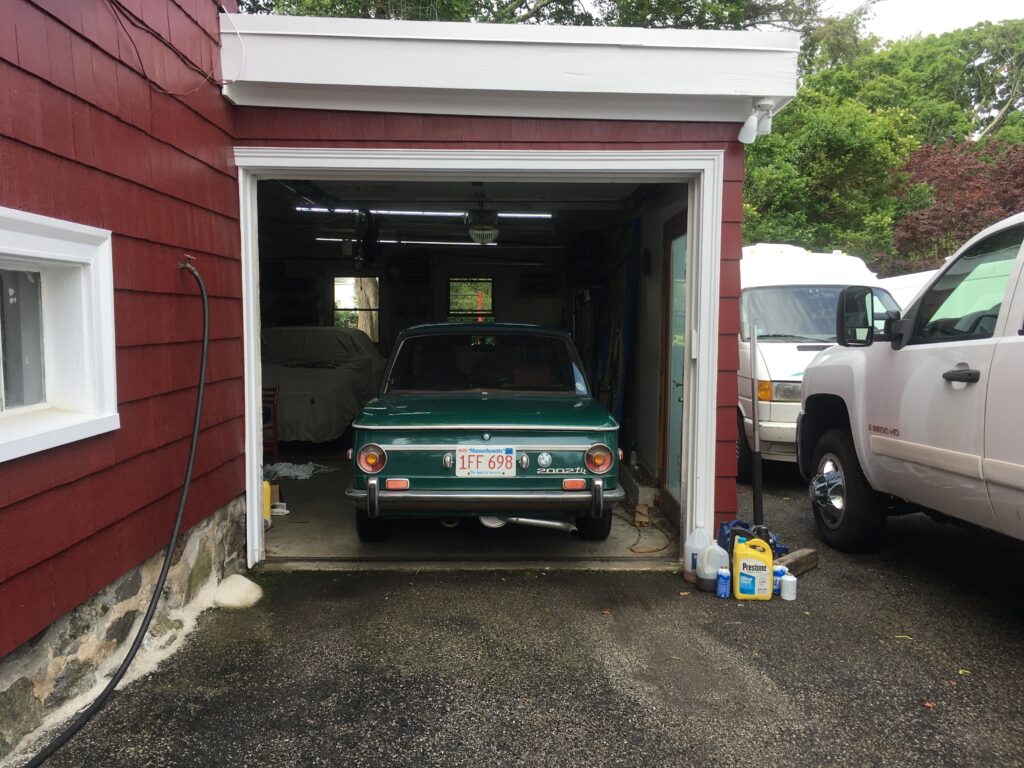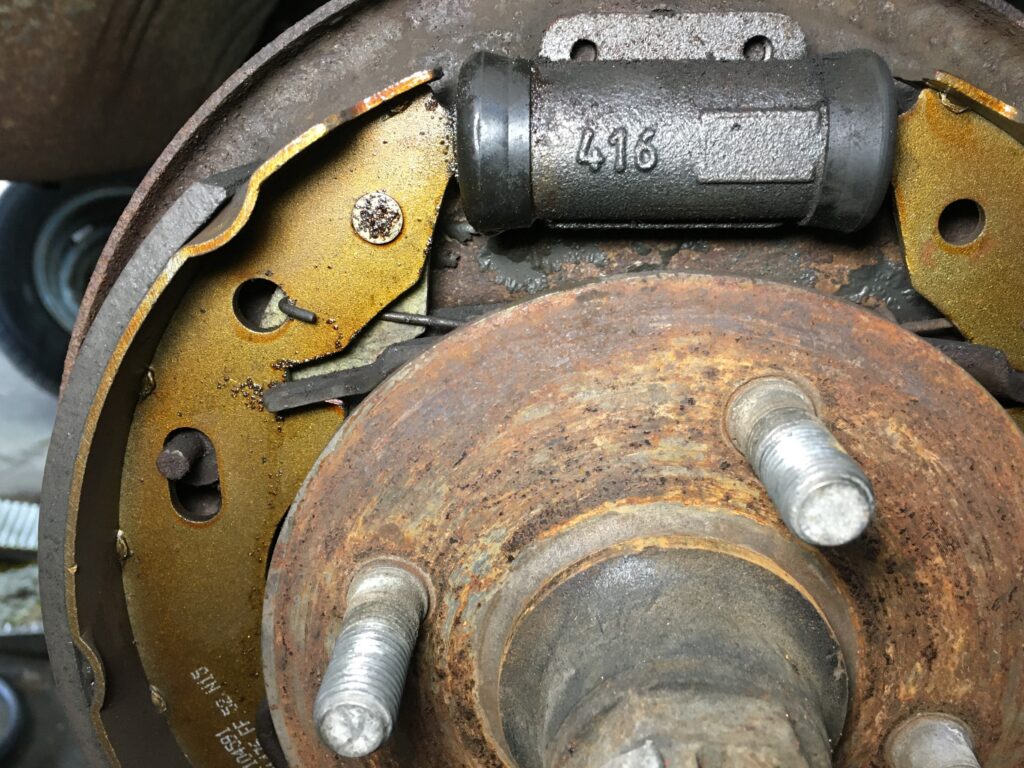A few months ago, I wrote about visiting the five cars I rent space for in the warehouse in Monson, Massachusetts, about 70 miles from me. Over two consecutive days, I brought home my Z3 M Coupe and my ’79 Euro 635CSi, but the visit wasn’t without its pitfalls, including lack of access to the cars due to their being blocked in by other vehicles. Early this week, I thought I’d try it again.
I’ve made no decision on the question of should I or shouldn’t I sell the M Coupe, so for the moment I’m happy with “no decision” being a decision. Selling a car means properly describing it, photographing it, advertising it, and showing it, and I simply don’t have the bandwidth right now. Still, the car is already at my house, a few folks have expressed interest, and it’s new enough (as opposed to being a rust-prone 1970s car) that I don’t feel I’m committing a crime against automanity if it sits outside for a bit if something else needs the garage space, so it can stay.
The 635CSi was at my house ostensibly so I could come to closure on recharging its a/c system, but when I pressure-tested it, it had a leak I couldn’t find. As I described here, I installed a proper set of R134a charging fittings, but the problem persisted. In the end, I think it’s likely that the leak may have been in the manifold gauge set or the hoses leading to it rather than in the car’s a/c. When I cranked the knobs at the ends of the gauge set’s hoses closed before letting it sit overnight, and then opened them in the morning, the reading only changed by about one psi, which can be caused by dropping temperatures overnight in the garage. So I shot two cans of R134a into it and charged it up.
With the car having functional air conditioning for the first time in four years, I began using it. I routinely describe the Euro Sixer as an arrestingly striking car that oozes presence, is great for road trips, but isn’t necessarily a fun around-town car. That’s true, but part of the joy of owning any of these cars is using them for everyday things, whether it’s running to Home Depot for some plumbing part or to Trader Joe’s to buy milk and cereal on a Sunday morning. A cool car turns an errand into an event. Sharkie may not be like the Lotus or any of the 2002s that I hop into for the pure joy of driving down leafy back roads, or like Zelda the Z3 where I can drop the top and get the rolling Xanax effect just going to get gas, but it is and always will be a car that I park and look back at and say “damn that’s a cool car,” and that’s something special.

Take THAT, Home Depot! And yes it’s positioned like that just for the photo. No I didn’t park like some jerk in a BMW.
Before I ran Sharkie back out to Monson, I did something that had been on my to-do list since I drove the car to the Vintage in 2019. This generation of E24, like my E9 coupe, has an undesirable heating attribute. Turning on the heat in the car isn’t like on a 2002 where a lever pulls a cable that opens up a valve that allows coolant to flow through the heater core. Coolant always flows through the heater core. Instead, the heater control level opens up a flap that allows the hot air that’s already inside the heater box to flow into the passenger cabin. Of course, with age, the foam that seals all the heater box’s flaps has long since deteriorated, so unless the heater box has recently been rebuilt, heat is always streaming into the passenger footwell, and even if it has, the box is still like a toaster oven sitting above the a/c evaporator assembly. On my E9, ten years ago I employed what was probably an over-engineered solution—I retrofitted a servo-actuated electric valve that can either bypass the heater core or bring it back on line, and that can be controlled from inside the car so you can open i just a smidge on a cold autumn morning, then close it. I wrote the process up in gross and gory detail on e9coupe.com here. However, over the years, others have pointed out that the main path that coolant takes is to be forced into the block by the water pump and rising up through the head, so you’re not depriving the engine of any cooling by using a blocking-style shut-off valve like a 2002. So, for Sharkie, I simply spliced in an actual spare 2002 heater control valve between the outlet on the back of the head and the inlet to the heater control box. It works perfectly. The footwells are now nice and cool.

This was very satisfying.
However, despite all the effort that went into Sharkie’s from-scratch a/c installation (as a German-spec 635CSi, this one had no a/c in it when I bought it), the air conditioning is functional but not frostbite-inducing. Much of that may be that the blower fan isn’t that strong, and unlike a 2002 or an E9, the cold air doesn’t emerge directly from the center console—it goes through ducts and comes out of vents in the dashboard that are further from your face. Still, for now, I called it good enough to drive the car in the summer heat the 70 miles out to Monson.

This is a bit misleading, as the photo was taken when it was overcast and not blindingly hot.
While it was fun having the clown shoe and Sharkie at the house at the same time (sort of like DeVito and Schwarzenegger as two silver “Twins”), their dual presence usurped the space for any of the three 2002s, and that drove me a little crazy. So, out to Monson Sharkie and I went so I could grab some 2002 goodness.

In you go, you big gorgeous cartilaginous Interstate eater.
I went straight for Louie, the ’72 2002tii featured in my book Ran When Parked. We had, as Beatrix Kiddo said in Kill Bill, “unfinished business.” When I checked out Louie the last time I was in Monson, I was surprised to find that the level in the brake fluid reservoir was very low, even below the level of the clutch pipe, indicating a likely brake hydraulic leak. At the time, I checked for puddles, didn’t find any (of course, the car had been moved inside the warehouse), checked for leaks, didn’t find any of those either, topped it up, got the car inspected, checked for leaks again, came up empty again, and shrugged.
This time, I found fluid, but not brake fluid—there was water on the trunk lid from the warehouse’s roof leaking above it.

Not what you want to see.
Now, you can flip out over this sort of thing, or you can regard it as part of a you-get-what-you-pay-for paradigm (the storage spaces cost me the unheard-of-low rate of $70/month). I did the latter. I checked to make certain that none of my other cars were being dripped on, then photographed the dripped-on car. When I pulled Louie out of the space, I made sure to park Sharkie a full space ahead of it, and photographed that as well. Then I texted the landlord, sent him the pics, and let him know what was up and why I was leaving a space unoccupied.
Back to the brakes. Facing a 70-mile drive home, I wanted to be as careful as possible, so even though the car has a functioning brake fluid level sensor and warning light, I stopped at regular intervals and checked the fluid level. It never moved, but the brakes felt spongy and seemed to have more pedal travel than they should.

I love all my cars, but seeing a round tail light tii in the garage always makes me a special kind of happy.
Brake fluid loss, particularly when it’s the better part of the contents of the reservoir, is almost always accompanied by visible wetness. As I said, I didn’t see any on a quick check in the warehouse, but now that I had the car at home, I put Louie up on the lift and, front to back, pored over the brake and clutch master cylinders, the front calipers, the clutch slave, the hard and soft brake lines, their junctions, and the backs of the rear-wheel cylinders and the backing plates, and didn’t see any signs of leakage. When this happens, the culprit is usually either the rear seal of the brake master cylinder where fluid leaks into the brake booster, or the clutch slave where fluid accumulates in the pedal box, but I checked both of these and came up empty (literally).
So I turned my eye to the brake pedal travel issue. On a car with drum brakes, excessive brake pedal travel is usually due to poorly adjusted rear shoes. I gave the rear brakes a quick adjustment, but they really weren’t that far off. Then I realized that even though I didn’t see brake fluid streaming out from the bottom of the drum or the rear backing plates, I should take the opportunity to lay eyes directly on the rear wheel cylinders, so I pulled the drums off. The left side looked clean, but on the right, I could see some moisture on the rear-facing side of the wheel cylinder and the trailing-side shoe.

The fine trail of brake fluid down the left shoe isn’t good.
I put a pair of wheel cylinders on order (they’re cheap), and put the drums back back on “for now.” I bled the brakes and test-drove the car, and the braking felt much better than it did before, but I’m unlikely to do any road-tripping in it until I know that both the fluid-loss issue and the pedal-travel problem aresolved.
On the plus side, unlike Sharkie’s retrofitted a/c system, Louie’s retrofitted Clardy a/c system is banging, providing the “It’s so cold that I need to redirect the vents somewhere other than on my face” performance that you want after going to all that work.
I like having Louie back at the house. It’s like having one of your kids move back with you. Of course, I have three sons, and two of them have already moved back with us. If the third one and the other two 2002s all move back, I’d have a space problem.
It’s a good life.
—Rob Siegel
____________________________________
Rob’s newest book, The Best of The Hack Mechanic, is available here on Amazon, as are his seven other books. Signed copies can be ordered directly from Rob here.





















